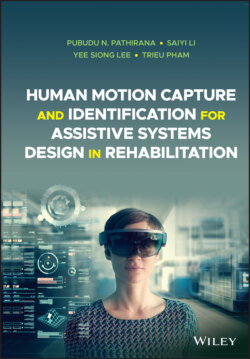Читать книгу Human Motion Capture and Identification for Assistive Systems Design in Rehabilitation - Pubudu N. Pathirana - Страница 25
1.5.2 Human motion encoders in physical telerehabilitation
ОглавлениеAlthough a number of encoding approaches have been investigated, not all of these approaches have been adopted in the physical telerehabilitation field, where the angles and trajectories of joints are usually utilised.
In these two representations, the angle‐based approach is more widely used. This is mainly because human limbs are normally modelled as articulated rigid bodies. Additionally, some measurement devices, such as IMUs, are able to measure the orientation of limbs easily. Therefore, angles of joints and orientation of limbs can be acquired without much difficulty. Limb segments are hinged together with various degrees of freedom (DOF), which can be seen in Tables 1.1 and 1.2.
A number of examples utilising angle and its derivatives as encoders can be found. For instance, Tseng et al. [357] evaluated two platforms (Octopus II and ECO) to capture human motions for home rehabilitation. In two platforms, angles of joints were measured to represent the movement of limbs by the same type of compass (TDCM3 electrical compass) and different accelerometers, including the FreeScale MMA7260QT accelerometer and the Hitachi‐Metal H34C accelerometer, respectively. Two types of angles were taken into consideration. One was the joint angle between limbs, such as the angle of the elbow and knee. The second type was the angle between the orientation of a sensor and gravity. Moreover, in the telerehabilitation system developed by Luo et al. [218], angles of joints were utilised to encode the movements of the upper extremity. In this system, the angles of the shoulder and wrist were measured by two IMUs, as these two joints were modelled with three degrees of freedom on each joint while those of the elbow and fingers were measured by an optical linear encoder (OLE) and a glove made by multiple OLEs because these joints could be modelled with one degree of freedom. Additionally, Durfee et al. [102] introduced two bilateral electrogoniometers in a home telerehabilitation system for post-stroke patients. These bilateral electrogoniometers were attached to the wrist and hand of a subject, respectively. The angles of flexion and extension movements in the wrist and the first MCP joints were measured to represent the movement of the wrist and hand. Two potentiometers (refer to Figure 1.10a) were utilised to calculate the angles of joints (θ) as
(1.4)
where the distance from the anatomic joint to the linkage joint is
(1.5)
Figure 1.10 Pictures of animals. Source: Durfee et al. [102]. © 2009, ASME.
Apart from the above three examples, in some studies where motion trajectories of joints are captured, angle information is still derived for encoding human movements. For example, Adams et al. [15] developed a virtual reality system to assess the motor function of upper extremities in daily living. To encode the movement, they used the swing angle of the shoulder joint along the Y and Z axes, the twist angle of the shoulder, the angle of the elbow, their first and second derivatives, the bone length of the collarbone, upper arm and forearm, as well as the pose (position, yaw and pitch) of the vector along the collarbone to describe the movement of the upper body. Here the collarbone is a virtual bone connecting two shoulders. These parameters were utilised in an unscented Kalman filter as state, while the positions of the shoulders, elbows and wrists reading from a Kinect formed the observation. Another example is that of Wenbing et al. [378], who evaluated the feasibility of using a single Kinect with a series of rules to assess the quality of movements in rehabilitation. Five movements, including hip abduction, bowling, sit to stand, can turn and toe touch, were studied in this paper. For the first four movements, angles were used as encoders. For instance, the change of angle between left and right thighs (the vector from the hip centre to the left and right knee) was used to represent the angle of hip abduction, while the dot product of two vectors (from the hip centre to the left and right shoulders) was utilised to compute the angle encoding the movement of bowling. Additionally, Olesh et al. [267] proposed an automated approach to assess the impairment of upper limb movements caused by stroke. To encode the movement of the upper extremities, the angle of four joints, including shoulder flexion‐extension, shoulder abduction‐adduction, elbow flexion‐extension and wrist flexion‐extension, were calculated with the 3D positions of joints measured with Kinect.
Though angles of joints, as well as their derivatives, are utilised widely in encoding human motions, trajectories of joints and their derivatives can also be observed in some rehabilitation and telerehabilitation applications.
The first example is that of Chang et al. [67], who developed a programme to use Kinect as the motion capture device for spinal cord injury (SCI) rehabilitation. In this programme, the trajectories of the hand, elbow and shoulder were recorded to represent the external rotation of upper extremities. Similarly, Su [339] also developed a rehabilitation system, named KHRD, to provide home‐based rehabilitation services. To represent human motions, two key features were used, including trajectories of joints, as well as their speed. Additionally, Cordella et al. [78] modified the Kinect into a marker‐based device to measure the positions of joints on a hand (refer to Figure 1.11). Markers with a dimension of 1.2 cm were attached to the joints of fingers, as well as the wrist. After detecting the centre of these markers, a robust tracking scheme was developed to track the position of each marker. Thus the movement of a hand was encoded by the trajectories of each joint on the hand, as well as the trajectory of the wrist.
